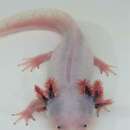Description of Amphibia
provided by BioPedia
The amphibia include toads, frogs, caecilians, and salamanders. They are cold-blooded tetrapods, unlike most other tetrapods (they do not form an amnion). Most amphibian undergo metamorphosis from a juvenile water-breathing form (tadpoe) to an adult air-breathing form, but some retain the juvenile water-breathing form throughout life. Mudpuppies, for example, retain juvenile gills in adulthood. The three modern orders of amphibia: Anura (frogs and toads); Caudata (salamanders and newts); and Gymnophiona (caecilians, limbless amphibians that resemble snakes). There are about 6,500 species. Many amphibians lay their eggs in water. Amphibia superficially resembles reptiles, but reptiles are amniotes, and have surface scales. In the lasdt 20 or 30 years, there has been a dramatic decline in amphibian populations around the globe. Many species are now threatened or extinct. The earliest amphibia evolved in the Devonian period from lobe-finned fish that used their strong, bony fins to venture onto dry land. They were the top predators in the Carboniferous and Permian periods, but they later faced competition from their descendants, the reptiles, and many lineages were wiped out during the PermianâTriassic extinction. One group, the metoposaurs, remained important predators during the Triassic, but as the world became drier during the Early Jurassic they died out, leaving a handful of relict temnospondyls like Koolasuchus and the Lissamphibia.

